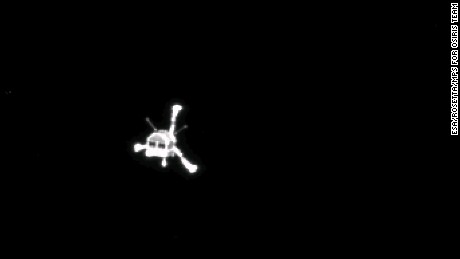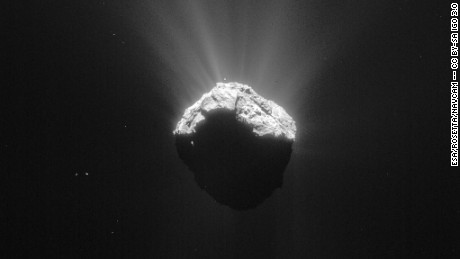Story highlights
- Rosetta is to begin listening for signs that the lander has survived the cold and dark
- From lander pictures, mission controllers think Philae is tucked up underneath a cliff face
- Philae has already detected organic chemicals on the comet surface
(CNN)Is Philae still alive? The answer to this particular cosmic cliff-hanger was left unresolved towards the end of last year.
The tiny space probe bounced across the surface of Comet 67P before touching down away from its intended landing zone. It returned plenty of data from the surface but ended up in a shady spot where there wasn't enough sunlight to keep it powered -- so then it went to sleep and nothing has been heard since November.
In the months since, mission scientists have not been able to pinpoint its exact resting place.
But now the comet-chasing mother ship Rosetta -- in orbit around 67P -- is to begin listening for signs that the lander has survived the cold and dark.
Scientists at the European Space Agency (ESA), which is leading a consortium that includes NASA to find out more about the composition of comets and how they interact with the Sun, believe that if enough sunlight falls on Philae's solar panels it could revive.
As the comet gets closer to the Sun and more light illuminates the lander, the chances improve.
Lander system engineer Laurence O'Rourke told CNN that Philae needs 5.5 watts of power to reboot itself, nine watts to switch on the receiver to accept communications and 19 watts to activate its transmitter and allow two-way communication with the orbiter. Modern energy-saving domestic light bulbs consume 20 watts or lower so it doesn't need much to re-establish contact.
On Tuesday, @ESA_Rosetta tweeted: "Excited! I have some opportunities to listen for @philae2014 to find out if he's awake!"
On the Rosetta mission blog, lander project manager Stephan Ulamec says: "It will probably still be too cold for the lander to wake up, but it is worth trying. The prospects will improve with each passing day."
The mission website adds that Philae could already have woken up but does not yet have sufficient power to communicate with Rosetta. It says Rosetta will transmit to Philae between March 12 and March 20, listening for a response.
Problems began for the lander when devices designed to anchor Philae to the surface failed. The gravity is so weak that without the harpoons intended to fire from the feet, the probe bounced across the comet.
However, the mishap could prove to be a happy accident.
O'Rourke explained that as the comet nears the Sun, Philae's original landing spot would have exposed it to temperatures that would have burned out its electronics. In that position it most likely would have died by now.
From lander pictures, mission controllers think Philae, which is about the size of a washing machine, is tucked up underneath a cliff face, affording it some shade.
Beginning Thursday, mission controllers will send what O'Rourke described as "blind commands" to Philae in the hope that the lander has enough power to receive instructions even if it can't respond. Philae will be told to save power for the transmitter.
O'Rourke admits that it's a "long shot" but the team will try again in April if this attempt fails.
If Philae revives it could be witness to an amazing show as the comet makes its closest approach to the Sun in August.
"I think we are going to see some amazing images at that point," said O'Rourke.
Even if Philae never wakes up, all is not lost. The mission has detected organic chemicals on the comet surface, though full details of that discovery have yet to be revealed.
And the Rosetta mission is already changing perceptions of comets. O'Rourke says instead of a comet being a dirty snowball he now thinks of it as being "an icy dirtball." He described discoveries of dust and large "boulders" circling the comet after they were blown off by the Sun during previous orbits, and an image that appears to show a structure the size of a football pitch that has been lifted and then deposited next to the hole.
"The Rosetta mission is not just about the lander. It's about orbiting and following a comet -- watching it wake up and then go to sleep again, finding the secrets held by comets. Every day is a new discovery," he said.
Scientists have already applauded the mission's success to date. "The Rosetta radar experiment will reveal for the first time how a comet is put together," cosmochemist Denton S. Ebel told CNN in November.

























































































